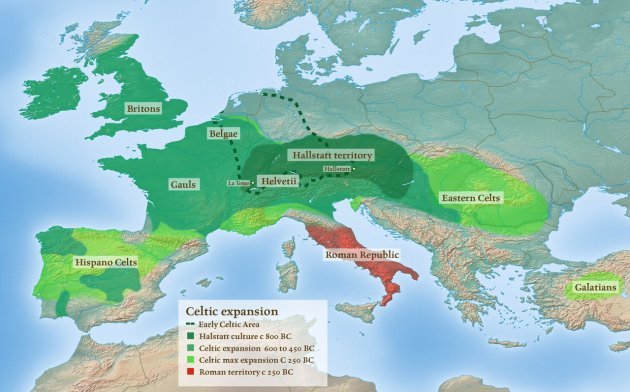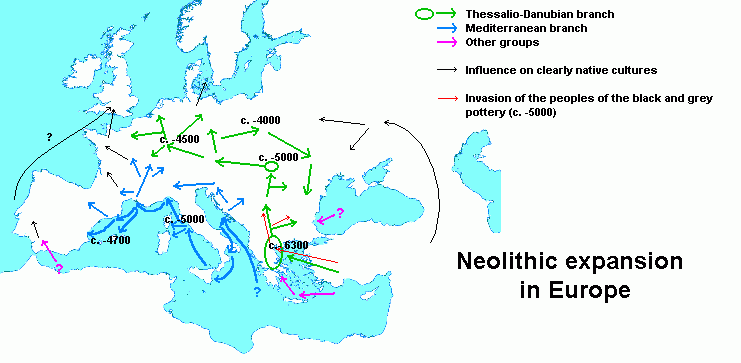 |
| Expansion of Hallstatt and subsequent La Téne horizons across Europe. |
Probably the most controversial question asked of mainstream Irish academia over the years is as to whether or not that Irish people can be categorised as a definitively 'Celtic' meta-ethnic group.
Until the past few decades, the general consensus amongst Irish scholars was that a migration from somewhere on continental Europe occurred c.500BC and thus with it bringing the precursor of the Irish language. However this theory has since waned in support due to the subsequent backlash of PC revisionism amongst academics during the 1990's. The word 'Celt' was added to the ever increasing list of racial slurs that you couldn't say anymore because it triggered people.
So are we or aren't we? And if not then what?
Well after spending a considerable amount of time playing around with different models on Global 25, I would actually in earnest say yes......but also no.
You see due to the dearth in available samples from prehistoric Ireland at this current moment in time, at least until may of next year when the embargo is lifted on the ancient Irish DNA compendium courtesy of Trinity college's science department, I have to improvise and make do with samples from across Bronze age Britain as substitute proxies. But beggars cannot be choosers I suppose.
In a previous post I mentioned that between now and the early bronze age period, at some point there was an admixture event which led to a 'southern shift' noticeable in contemporary Irish genomes relative to the more 'northern' Rathlin samples who share most drift with Dutch beakers of which Irish score around 80% as on Global 25.
 |
| As you can see being isolated on an island for four millenia has led to a fair bit of drift since then. Dstats courtesy of Eurogenes blog. |
So what caused this southern shift? I think the answer at this stage is fairly obvious. Last year foremost population geneticist David Reich of Harvard commented that during the Iron age in south-east England samples show evidence of a resurgence in EEF like admixture. One of the scenarios postulated was introgression from a remnant neolithic survivor population subsisting on the island, but I think this is unlikely. Given it's closer proximity to the continent, I believe a population of Hallstatt or perhaps even later La Téne Celts (or both) arrived, and mixed with the LBA population, whose mixed descendants then took over the island with their superior Iron technology and chariots. Gaius Julius Caesar comments in his 'De Bello Gallico' how certain Gallic tribes such as the 'Belgae' made frequent sorties across the channel to Britain.
During the period of the EIA after the collapse of the Bronze age trading networks which connected all of Europe and plunging temperatures resulted in a collapse of the Irish population from a BA high of around 100,000 to perhaps as low as 20,000 people by 300BC. It would not have been particularly difficult for a mannerbund of Iron sword wielding elites from abroad to take over and spread their language, culture and of course genes too.
Something like this is what I believe probably occurred in Ireland which led to a more fractured and tribal lifestyle were petty kingdoms waged war via launching surprise cattle raids on each other. And when modelling Irish using Irish_EBA and various Hallstatt and another attested and surprisingly northern Celtic sample from the Greek colony of Empuriés in Catalonia, this geneflow is very apparent.
In a blog post back in 2018 Davidski (see here) using qpAdmix modelled Iron age samples from Hinxton obtaining similar scores to the one shown above, though on Global 25 the models are not immune to being skewed by genetic drift which these Bronze Age 'Irish' naturally share with these Iron age samples from the continent. So for the most part we can be chalked up as 'Celticised Beakers' (Celts came from Bell beakers anyway) with some later introgression from Norwegian Vikings (I'll be doing a post on this later) and subsequent Anglo-Normans whom resemble the Irish autosomally anyway.
Thankfully Davidski (PBUH) went through the trouble of revealing this genetic drift between Bronze, Iron and Modern era populations on a PCA chart.
 |
| PCA courtesy of Eurogenes blog. |
What is apparent to me first and foremost from this is that Irish, Scottish and Welsh cluster closer to the BA cline than both IA Britons and modern English, whom are noticeably shifted towards the Belgian like Hallstatt samples from Bylany. This seems to verify what David Reich stated last year that an admixture event occurred somewhere in the vicinity of SE England and from there, Celtic culture spread out across the Isles and by 300BC La Téne artefacts start popping up in Ireland, probably from across the Irish sea via somewhere in North England. Interestingly a tribe called the 'Brigantes' make a sudden appearance in SE Ireland around this time. Identical in name to the one from northern England fleeing Roman expansion a few centuries later. These Brythonic tribes may have come as refugees and adopted the more archaic Gaelic language, which appears to represent a more basal layer of Celtic language that probably spread a few centuries earlier.
They may also have brought the famed R1b-M222 snp found predominatly in Ulster of which basal subclades are found in Britain, perhaps spreading with La Téne migrants?
But of course aren't we all immigrants afterall? (lol jk)







